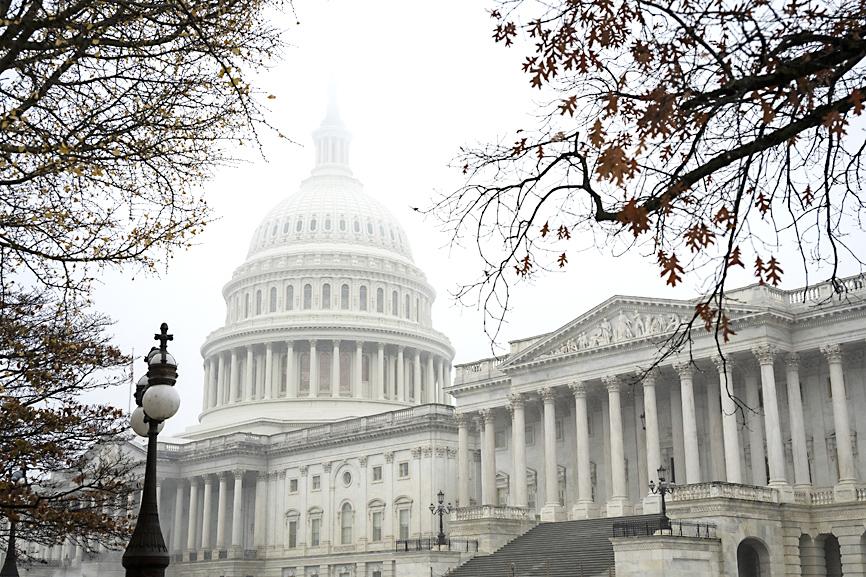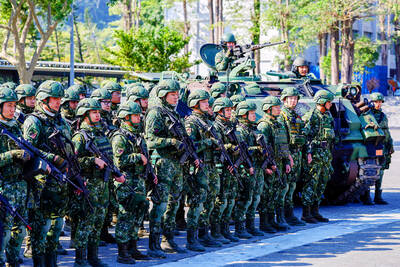The US House of Representatives on Wednesday approved a US$895 billion National Defense Authorization Act (NDAA), which authorizes the Pentagon to provide up to US$300 million worth of military articles and training in support of Taiwan.
In a 281-140 vote, the House approved the 1,800-page national security bill to authorize funding for the US Department of Defense for next fiscal year.
US Representative Jack Bergman, chairman of the US House Armed Services Subcommittee on Intelligence and Special Operations, before the vote said that it was a “critically important bill” that authorizes a Taiwan Security Cooperation Initiative, which would enable Taiwan to maintain its self-defense capabilities.

Photo: Graeme Sloan, EPA-EFE
US Representative John Moolenaar, chairman of the US House Select Committee on the Strategic Competition between the US and the Chinese Communist Party, in a statement after the vote said that the bill requires “a feasibility study of entering into defense industrial agreements with Taiwan to promote lethality and supply chain resilience.”
Under the act, the US Department of Defense is authorized to earmark up to US$300 million next year to promote the Taiwan Security Cooperation Initiative.
A source on the US House Armed Service Committee on Tuesday said that the initiative is modeled on the Ukraine Security Assistance Initiative, which allows the US to purchase military equipment directly from private companies for allies or partners.
The NDAA would allow the US Department of Defense and the US Department of State to augment Taiwan’s military capabilities in areas such as anti-tank, uncrewed aerial vehicles, long-range precision weapons, cyberdefense, electronic warfare and counter-electronic warfare capabilities, and integrated air and missile defense systems.
It also authorizes the provision of radars, anti-ship missiles, secure communications equipment, ammunition, intelligence, surveillance and reconnaissance support, and critical combat training.
To speed up the delivery of arms to Taiwan, the bill requires the state and defense departments to provide Taiwan with defense articles and services from US inventories, and to provide defense supplies to foreign partners to replenish the stocks of similar supplies provided by those governments to Taiwan.
The bill also contains provisions related to the establishment of a partnership program between the US and Taiwan on military trauma care, amputation and amputee care, and mental health conditions associated with post-traumatic stress disorder.
The NDAA includes a “sense of congress” — a formal expression of opinion, but is not legally binding — that proposes inviting Taiwan’s naval forces to participate in next year’s Rim of the Pacific exercise.
It also includes another bill called the “BOLSTER Act,” which would pave the way for the US and its European counterparts to develop “coordinated plans” in response to any attempts by China to overthrow Taiwan’s government or occupy any of the territory under Taipei’s control.
Similar measures could also be imposed if China mounts cyberattacks that threaten civilian or military infrastructure in Taiwan or imposes a naval blockade around Taiwan.
The bill also requires the US president to submit a report to the US Senate Committee on Foreign Relations and to the US House Committee on Foreign Affairs on the expected economic impact of the Chinese People’s Liberation Army’s 30-day and 180-day blockade or quarantine of Taiwan.
The NDAA, finalized by the US Senate and House on Saturday, required the approval of both chambers of the US Congress and is to take effect once signed into law by the US president.
The allocation requires the passage of a separate appropriations bill.

UNILATERAL MOVES: Officials have raised concerns that Beijing could try to exert economic control over Kinmen in a key development plan next year The Civil Aviation Administration (CAA) yesterday said that China has so far failed to provide any information about a new airport expected to open next year that is less than 10km from a Taiwanese airport, raising flight safety concerns. Xiamen Xiangan International Airport is only about 3km at its closest point from the islands in Kinmen County — the scene of on-off fighting during the Cold War — and construction work can be seen and heard clearly from the Taiwan side. In a written statement sent to Reuters, the CAA said that airports close to each other need detailed advanced

Tropical Storm Fung-Wong would likely strengthen into a typhoon later today as it continues moving westward across the Pacific before heading in Taiwan’s direction next week, the Central Weather Administration (CWA) said. As of 8am, Fung-Wong was about 2,190km east-southeast of Cape Oluanpi (鵝鑾鼻), Taiwan’s southernmost point, moving westward at 25kph and possibly accelerating to 31kph, CWA data showed. The tropical storm is currently over waters east of the Philippines and still far from Taiwan, CWA forecaster Tseng Chao-cheng (曾昭誠) said, adding that it could likely strengthen into a typhoon later in the day. It is forecast to reach the South China Sea

Almost a quarter of volunteer soldiers who signed up from 2021 to last year have sought early discharge, the Legislative Yuan’s Budget Center said in a report. The report said that 12,884 of 52,674 people who volunteered in the period had sought an early exit from the military, returning NT$895.96 million (US$28.86 million) to the government. In 2021, there was a 105.34 percent rise in the volunteer recruitment rate, but the number has steadily declined since then, missing recruitment targets, the Chinese-language United Daily News said, citing the report. In 2021, only 521 volunteers dropped out of the military, the report said, citing

WEATHER Typhoon forming: CWA A tropical depression is expected to form into a typhoon as early as today, the Central Weather Administration (CWA) said yesterday, adding that the storm’s path remains uncertain. Before the weekend, it would move toward the Philippines, the agency said. Some time around Monday next week, it might reach a turning point, either veering north toward waters east of Taiwan or continuing westward across the Philippines, the CWA said. Meanwhile, the eye of Typhoon Kalmaegi was 1,310km south-southeast of Oluanpi (鵝鑾鼻), Taiwan’s southernmost point, as of 2am yesterday, it said. The storm is forecast to move through central